Enhanced Thermal Stability in Dielectric Properties of NaNbO3–Modified BaTiO3–BiMg1/2Ti1/2O3 Ceramics for X9R-MLCC Applications
Abstract
:1. Introduction
2. Materials and Methods
3. Results
4. Conclusions
Supplementary Materials
Author Contributions
Funding
Institutional Review Board Statement
Informed Consent Statement
Acknowledgments
Conflicts of Interest
References
- Gurav, A.; Xu, X.; Freeman, Y.; Reed, E. KEMET Electronics: Breakthroughs in Capacitor Technology. In Materials Research for Manufacturing; Springer: Cham, Switzerland, 2016; pp. 93–129. [Google Scholar]
- Reynolds, C. Tantalum Capacitor Technology: Options for high-temperature and harsh-environment applications. IEEE Power Electron. Mag. 2017, 4, 43–47. [Google Scholar] [CrossRef]
- Zeb, A.; Milne, S. High temperature dielectric ceramics: A review of temperature-stable high-permittivity perovskites. J. Mater. Sci. Mater. Electron. 2015, 26, 9243–9255. [Google Scholar] [CrossRef]
- Peddigari, M.; Palneedi, H.; Hwang, G.-T.; Ryu, J. Linear and nonlinear dielectric ceramics for high-power energy storage capacitor applications. J. Korean Ceram. Soc. 2018, 56, 1–23. [Google Scholar] [CrossRef] [Green Version]
- Pan, M.-J.; Randall, C.A. A brief introduction to ceramic capacitors. IEEE Electr. Insul. Mag. 2010, 26, 44–50. [Google Scholar] [CrossRef]
- Li, D.; Zeng, X.; Li, Z.; Shen, Z.-Y.; Hao, H.; Luo, W.; Wang, X.; Song, F.; Wang, Z.; Li, Y. Progress and perspectives in dielectric energy storage ceramics. J. Adv. Ceram. 2021, 10, 675–703. [Google Scholar] [CrossRef]
- Wang, H.; Zhao, P.; Chen, L.; Li, L.; Wang, X. Energy storage properties of 0.87BaTiO3-0.13Bi(Zn2/3(Nb0.85Ta0.15)1/3)O3 multilayer ceramic capacitors with thin dielectric layers. J. Adv. Ceram. 2020, 9, 292–302. [Google Scholar] [CrossRef]
- Wang, G.; Lu, Z.; Li, Y.; Li, L.; Ji, H.; Feteira, A.; Zhou, D.; Wang, D.; Zhang, S.; Reaney, I.M. Electroceramics for High-Energy Density Capacitors: Current Status and Future Perspectives. Chem. Rev. 2021, 121, 6124–6172. [Google Scholar] [CrossRef] [PubMed]
- Morrison, F.D.; Sinclair, D.C.; West, A.R. Doping mechanisms and electrical properties of La-doped BaTiO3 ceramics. Int. J. Inorg. Mater. 2001, 3, 1205–1210. [Google Scholar] [CrossRef]
- Gao, S.; Wu, S.; Zhang, Y.; Yang, H.; Wang, X. Study on the microstructure and dielectric properties of X9R ceramics based on BaTiO3. Mater. Sci. Eng. B 2011, 176, 68–71. [Google Scholar] [CrossRef]
- Wang, S.-F.; Li, J.-H.; Hsu, Y.-F.; Wu, Y.-C.; Lai, Y.-C.; Chen, M.-H. Dielectric properties and microstructures of non-reducible high-temperature stable X9R ceramics. J. Eur. Ceram. Soc. 2013, 33, 1793–1799. [Google Scholar] [CrossRef]
- Watson, J.; Castro, G. A review of high-temperature electronics technology and applications. J. Mater. Sci. Mater. Electron. 2015, 26, 9226–9235. [Google Scholar] [CrossRef]
- Zhou, S.; Pu, Y.; Zhang, X.; Shi, Y.; Feng, Y.; Shen, G.; Ouyang, T.; Jia, J.; Zhang, Q.; Wang, D. High energy density, temperature stable lead-free ceramics by introducing high entropy perovskite oxide. Chem. Eng. J. 2022, 427, 131684. [Google Scholar] [CrossRef]
- Normann, R.A. First High-Temperature Electronics Products Survey 2005; Sandia National Laboratories: Albuquerque, NM, USA, 2006.
- Johnson, R.W.; Evans, J.L.; Jacobsen, P.; Thompson, J.R.; Christopher, M. The changing automotive environment: High-temperature electronics. IEEE Trans. Electron. Packag. Manuf. 2004, 27, 164–176. [Google Scholar] [CrossRef]
- Han, Y.; Qian, J.; Yang, C. Fatigue-free dielectric capacitor with giant energy density based on lead-free Na0.5Bi0.5TiO3-based film. J. Mater. Sci. Mater. Electron. 2019, 30, 21369–21376. [Google Scholar] [CrossRef]
- Meena, V.; Dotaniya, M.L.; Saha, J.K.; Das, H.; Patra, A.K. Impact of Lead Contamination on Agroecosystem and Human Health. In Lead in Plants and the Environment; Springer: Berlin/Heidelberg, Germany, 2020; pp. 67–82. [Google Scholar]
- Ibn-Mohammed, T.; Koh, S.; Reaney, I.; Sinclair, D.; Mustapha, K.; Acquaye, A.; Wang, D. Are lead-free piezoelectrics more environmentally friendly? MRS Commun. 2017, 7, 1–7. [Google Scholar] [CrossRef] [Green Version]
- Ibn-Mohammed, T.; Koh, S.; Reaney, I.; Acquaye, A.; Wang, D.; Taylor, S.; Genovese, A. Integrated hybrid life cycle assessment and supply chain environmental profile evaluations of lead-based (lead zirconate titanate) versus lead-free (potassium sodium niobate) piezoelectric ceramics. Energy Environ. Sci. 2016, 9, 3495–3520. [Google Scholar] [CrossRef] [Green Version]
- Wang, D.; Wang, G.; Murakami, S.; Fan, Z.; Feteira, A.; Zhou, D.; Sun, S.; Zhao, Q.; Reaney, I.M. BiFeO3-BaTiO3: A new generation of lead-free electroceramics. J. Adv. Dielectr. 2018, 8, 1830004. [Google Scholar] [CrossRef] [Green Version]
- Xu, J.; Lu, Q.; Lin, J.; Lin, C.; Zheng, X.; Lin, T.; Wu, X. Enhanced ferro-/piezoelectric properties of tape-casting-derived Er3+-doped Ba0.85Ca0.15Ti0.9Zr0.1O3 optoelectronic thick films. J. Adv. Ceram. 2020, 9, 693–702. [Google Scholar] [CrossRef]
- Fan, Y.; Wang, Z.; Huan, Y.; Wei, T.; Wang, X. Enhanced thermal and cycling reliabilities in (K,Na)(Nb,Sb)O3-CaZrO3-(Bi, Na)HfO3 ceramics. J. Adv. Ceram. 2020, 9, 349–359. [Google Scholar] [CrossRef]
- Cen, Z.; Bian, S.; Xu, Z.; Wang, K.; Guo, L.; Li, L.; Wang, X. Simultaneously improving piezoelectric properties and temperature stability of Na0.5K0.5NbO3 (KNN)-based ceramics sintered in reducing atmosphere. J. Adv. Ceram. 2021, 10, 820–831. [Google Scholar] [CrossRef]
- Albertsen, K.; Hennings, D.; Steigelmann, O. Donor-acceptor charge complex formation in barium titanate ceramics: Role of firing atmosphere. J. Electroceram. 1998, 2, 193–198. [Google Scholar] [CrossRef]
- Arshad, M.; Du, H.; Javed, M.S.; Maqsood, A.; Ashraf, I.; Hussain, S.; Ma, W.; Ran, H. Fabrication, structure, and frequency-dependent electrical and dielectric properties of Sr-doped BaTiO3 ceramics. Ceram. Int. 2020, 46, 2238–2246. [Google Scholar] [CrossRef]
- Li, W.-B.; Zhou, D.; Liu, W.-F.; Su, J.-Z.; Hussain, F.; Wang, D.-W.; Wang, G.; Lu, Z.-L.; Wang, Q.-P. High-temperature BaTiO3-based ternary dielectric multilayers for energy storage applications with high efficiency. Chem. Eng. J. 2021, 414, 128760. [Google Scholar] [CrossRef]
- Yang, H.; Lu, Z.; Li, L.; Bao, W.; Ji, H.; Li, J.; Feteira, A.; Xu, F.; Zhang, Y.; Sun, H. Novel BaTiO3-based, Ag/Pd-compatible lead-free relaxors with superior energy storage performance. ACS Appl. Mater. Interfaces 2020, 12, 43942–43949. [Google Scholar] [CrossRef] [PubMed]
- Zhao, H.; Ren, P.; Hua, Q.; Liu, L.; Wang, X.; Wan, Y.; Yan, F.; Zhao, G.; Wang, D. Temperature stable (1−x)(0.9Na0.5Bi0.5TiO3-0.1BiAlO3)-xNaTaO3 ceramics and capacitors with ultra-wide operational range. J. Alloys Compd. 2021, 886, 161315. [Google Scholar] [CrossRef]
- Muhammad, R.; Iqbal, Y.; Reaney, I.M. BaTiO3–Bi(Mg2/3Nb1/3)O3 ceramics for high-temperature capacitor applications. J. Am. Ceram. Soc. 2016, 99, 2089–2095. [Google Scholar] [CrossRef]
- Zhang, Q.; Li, Z.; Li, F.; Xu, Z. Structural and dielectric properties of Bi(Mg1/2Ti1/2)O3–BaTiO3 lead-free ceramics. J. Am. Ceram. Soc. 2011, 94, 4335–4339. [Google Scholar] [CrossRef]
- Sun, R.; Wang, X.; Shi, J.; Wang, L. Dielectric and polar order behaviors of BaTiO3-Bi(Mg1/2Ti1/2)O3 ceramics. Appl. Phys. A 2011, 104, 129–133. [Google Scholar] [CrossRef]
- Xiong, B.; Hao, H.; Zhang, S.; Liu, H.; Cao, M. Structure, dielectric properties and temperature stability of BaTiO3–Bi(Mg1/2Ti1/2)O3 perovskite solid solutions. J. Am. Ceram. Soc. 2011, 94, 3412–3417. [Google Scholar] [CrossRef]
- Choi, D.H.; Baker, A.; Lanagan, M.; Trolier-McKinstry, S.; Randall, C. Structural and Dielectric Properties in (1 − x)BaTiO3–xBi(Mg1/2Ti1/2)O3 Ceramics (0.1 ≤ x ≤ 0.5) and Potential for High-Voltage Multilayer Capacitors. J. Am. Ceram. Soc. 2013, 96, 2197–2202. [Google Scholar] [CrossRef]
- Ren, P.; Wang, X.; Fan, H.; Ren, Y.; Zhao, G. Structure, relaxation behaviors and nonlinear dielectric properties of BaTiO3–Bi(Ti0.5Mg0.5)O3 ceramics. Ceram. Int. 2015, 41, 7693–7697. [Google Scholar] [CrossRef]
- Muhammad, R.; Iqbal, Y. Enhanced dielectric properties in Nb-doped BT-BMT ceramics. Ceram. Int. 2016, 42, 19413–19419. [Google Scholar] [CrossRef]
- Si, F.; Tang, B.; Fang, Z.; Zhang, S. Nb-doped 0.8BaTiO3-0.2Bi(Mg0.5Ti0.5)O3 ceramics with stable dielectric properties at high temperature. Crystals 2017, 7, 168. [Google Scholar] [CrossRef] [Green Version]
- Muhammad, R.; Khesro, A. Influence of A-site nonstoichiometry on the electrical properties of BT-BMT. J. Am. Ceram. Soc. 2017, 100, 1091–1097. [Google Scholar] [CrossRef]
- Muhammad, R.; Camargo, J.; Prado, A.; Castro, M.S. Temperature stable relative permittivity from −60 to 200 °C in 75BaTiO3–(25−x)BiMg0.5Ti0.5O3–xNaNbO3 ceramics with X9R like characteristics. Mater. Lett. 2018, 233, 258–262. [Google Scholar] [CrossRef]
- Roncal-Herrero, T.; Harrington, J.; Zeb, A.; Milne, S.J.; Brown, A.P. Analytical Electron Microscopy Characterization of a Temperature-Stable Relaxor Ferroelectric Ceramic. Microsc. Microanal. 2019, 25, 2118–2119. [Google Scholar] [CrossRef] [Green Version]
- Zeb, A.; Milne, S.J. Dielectric stability in the relaxor: Na0.5Bi0.5TiO3-Ba0.8Ca0.2TiO3-Bi (Mg0.5Ti0.5)O3-NaNbO3 ceramic system. Ceram. Int. 2018, 44, 7663–7666. [Google Scholar] [CrossRef] [Green Version]
- Xie, J.; Yao, Z.; Hao, H.; Xie, Y.; Li, Z.; Liu, H.; Cao, M. A novel lead-free bismuth magnesium titanate thin films for energy storage applications. J. Am. Ceram. Soc. 2019, 102, 3819–3822. [Google Scholar] [CrossRef]
- Zhang, W.; Yang, J.; Wang, F.; Chen, X.; Mao, H. Enhanced dielectric properties of La-doped 0.75BaTiO3-0.25Bi(Mg0.5Ti0.5)O3 ceramics for X9R-MLCC application. Ceram. Int. 2021, 47, 4486–4492. [Google Scholar] [CrossRef]
- Zhou, M.; Liang, R.; Zhou, Z.; Dong, X. Developing a novel high performance NaNbO3-based lead-free dielectric capacitor for energy storage applications. Sustain. Energy Fuels 2020, 4, 1225–1233. [Google Scholar] [CrossRef]
- Shi, R.; Pu, Y.; Wang, W.; Guo, X.; Li, J.; Yang, M.; Zhou, S. A novel lead-free NaNbO3–Bi(Zn0.5Ti0.5)O3 ceramics system for energy storage application with excellent stability. J. Alloys Compd. 2020, 815, 152356. [Google Scholar] [CrossRef]
- Shannon, R.D. Revised effective ionic radii and systematic studies of interatomic distances in halides and chalcogenides. Acta Crystallog. A 1976, 32, 751–767. [Google Scholar] [CrossRef]
- Huang, X.; Liu, H.; Song, Z.; Hao, H.; Zhang, W.; Xu, Q.; Peng, C.; Huang, L.; Cao, M. Structure–property relationships in BaTiO3–(Na1/4Bi3/4)(Mg1/4Ti3/4)O3 lead-free ceramics. J. Eur. Ceram. Soc. 2016, 36, 533–540. [Google Scholar] [CrossRef]
- Chen, X.; Chen, J.; Ma, D.; Fang, L.; Zhou, H. Thermally stable BaTiO3-Bi(Mg2/3Nb1/3)O3 solid solution with high relative permittivity in a broad temperature usage range. J. Am. Ceram. Soc. 2015, 98, 804–810. [Google Scholar] [CrossRef]
- Ma, D.; Chen, X.; Huang, G.; Chen, J.; Zhou, H.; Fang, L. Temperature stability, structural evolution and dielectric properties of BaTiO3–Bi(Mg2/3Ta1/3)O3 perovskite ceramics. Ceram. Int. 2015, 41, 7157–7161. [Google Scholar] [CrossRef]
- Sun, Y.; Liu, H.; Hao, H.; Zhang, S. Effect of oxygen vacancy on electrical property of acceptor doped BaTiO3–Na0.5Bi0.5TiO3–Nb2O5 X8R systems. J. Am. Ceram. Soc. 2016, 99, 3067–3073. [Google Scholar] [CrossRef]
- Pokorný, J.; Pasha, U.; Ben, L.; Thakur, O.; Sinclair, D.; Reaney, I. Use of Raman spectroscopy to determine the site occupancy of dopants in BaTiO3. J. Appl. Phys. 2011, 109, 114110. [Google Scholar] [CrossRef]
- Kishi, H.; Mizuno, Y.; Chazono, H. Base-metal electrode-multilayer ceramic capacitors: Past, present and future perspectives. Jpn. J. Appl. Phys. 2003, 42, 1. [Google Scholar] [CrossRef]
- Raengthon, N.; Brown-Shaklee, H.; Brennecka, G.; Cann, D. Dielectric properties of BaTiO3–Bi(Zn1/2Ti1/2)O3–NaNbO3 solid solutions. J. Mater. Sci. 2013, 48, 2245–2250. [Google Scholar] [CrossRef] [Green Version]
- Lu, X.; Hou, L.; Jin, L.; Wang, L.; Tian, Y.; Yu, K.; Hu, Q.; Zhang, L.; Wei, X. Structure evolution and exceptionally ultra-low hysteresis unipolar electric field-induced strain in (1 − x)NaNbO3-xBaTiO3 lead-free ferroelectrics. Ceram. Int. 2018, 44, 5492–5499. [Google Scholar] [CrossRef]
- Wang, Y.; Pu, Y.; Zheng, H.; Jin, Q.; Gao, Z. Enhanced dielectric relaxation in (1 − x)BaTiO3–xBiYO3 ceramics. Mater. Lett. 2016, 181, 358–361. [Google Scholar] [CrossRef]
- Zhu, C.; Cai, Z.; Luo, B.; Guo, L.; Li, L.; Wang, X. High temperature lead-free BNT-based ceramics with stable energy storage and dielectric properties. J. Mater. Chem. A 2020, 8, 683–692. [Google Scholar] [CrossRef]
- Smolenskii, G.A.E. Physical phenomena in ferroelectrics with diffused phase transition. J. Phys. Soc. Jpn. 1970, 28, 26–37. [Google Scholar]
- Uchino, K.; Nomura, S. Critical exponents of the dielectric constants in diffused-phase-transition crystals. Ferroelectrics 1982, 44, 55–61. [Google Scholar] [CrossRef]
- Du, H.; Zhou, W.; Luo, F.; Zhu, D.; Qu, S.; Pei, Z. Phase structure, dielectric properties, and relaxor behavior of (K0.5Na0.5)NbO3–(Ba0.5Sr0.5)TiO3 lead-free solid solution for high temperature applications. J. Appl. Phys. 2009, 105, 124104. [Google Scholar] [CrossRef]
- Jia, W.; Hou, Y.; Zheng, M.; Zhu, M. High-temperature dielectrics based on (1 − x)(0.94Bi0.5Na0.5TiO3-0.06BaTiO3)-xNaNbO3 system. J. Alloys Compd. 2017, 724, 306–315. [Google Scholar] [CrossRef]
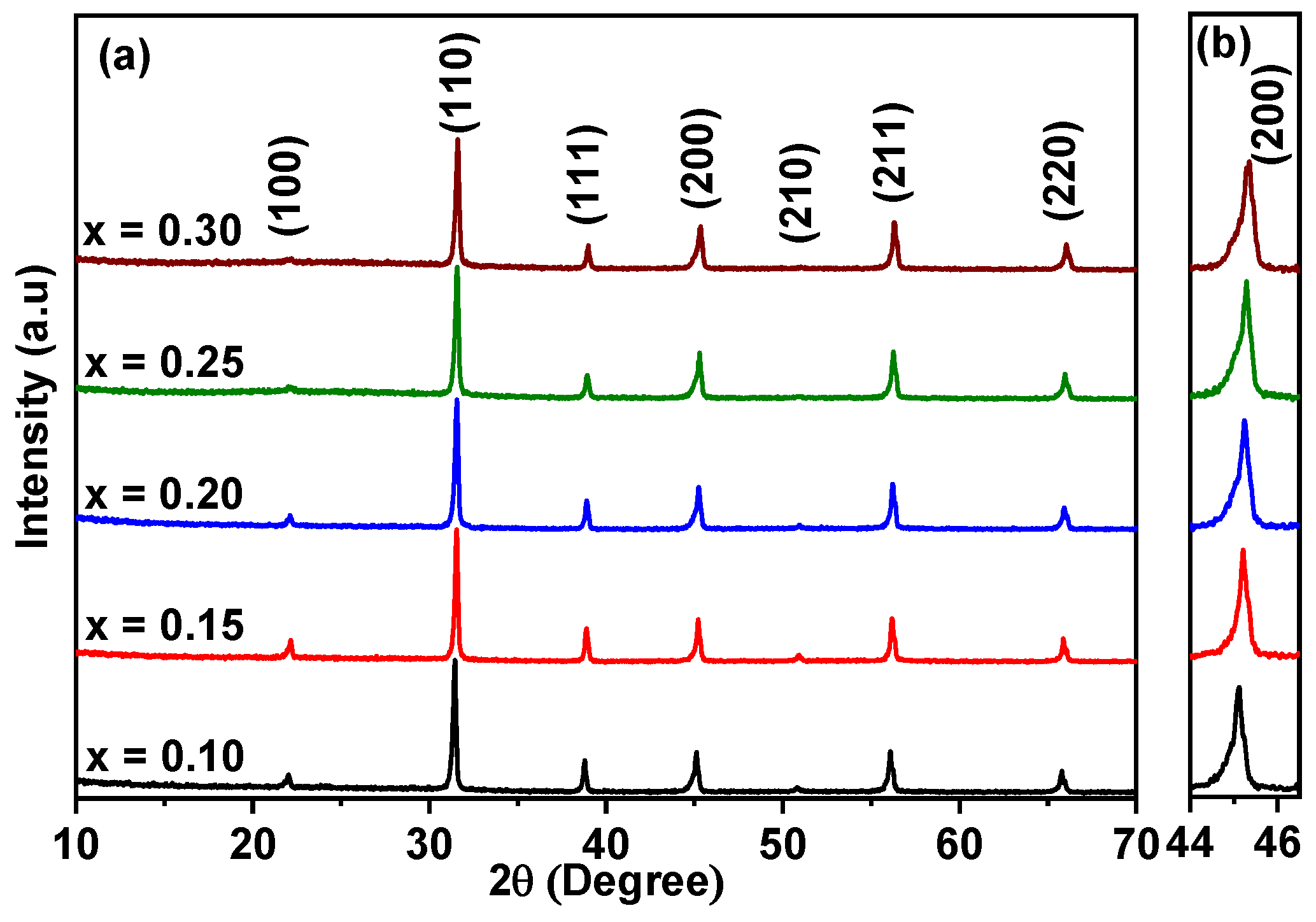
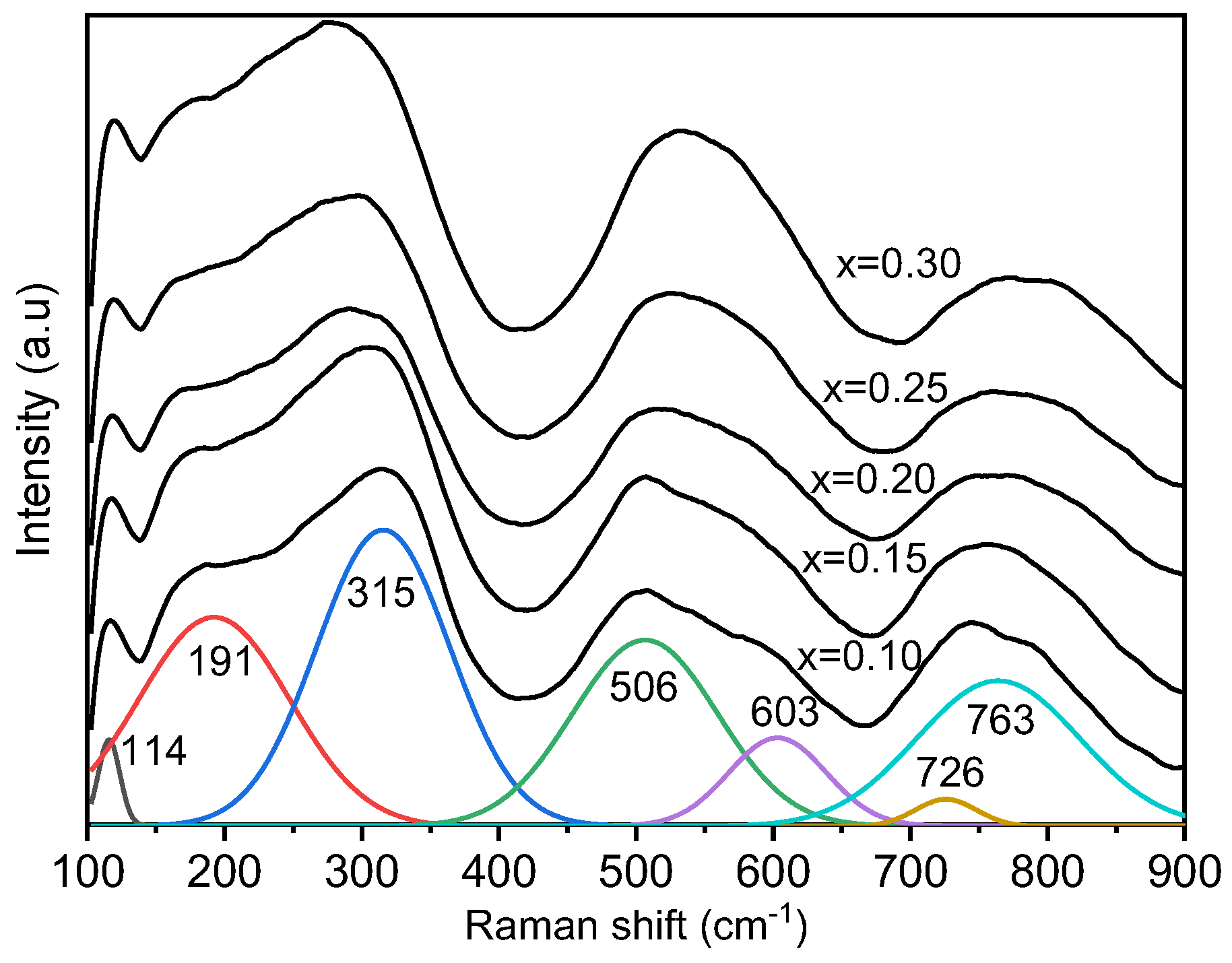
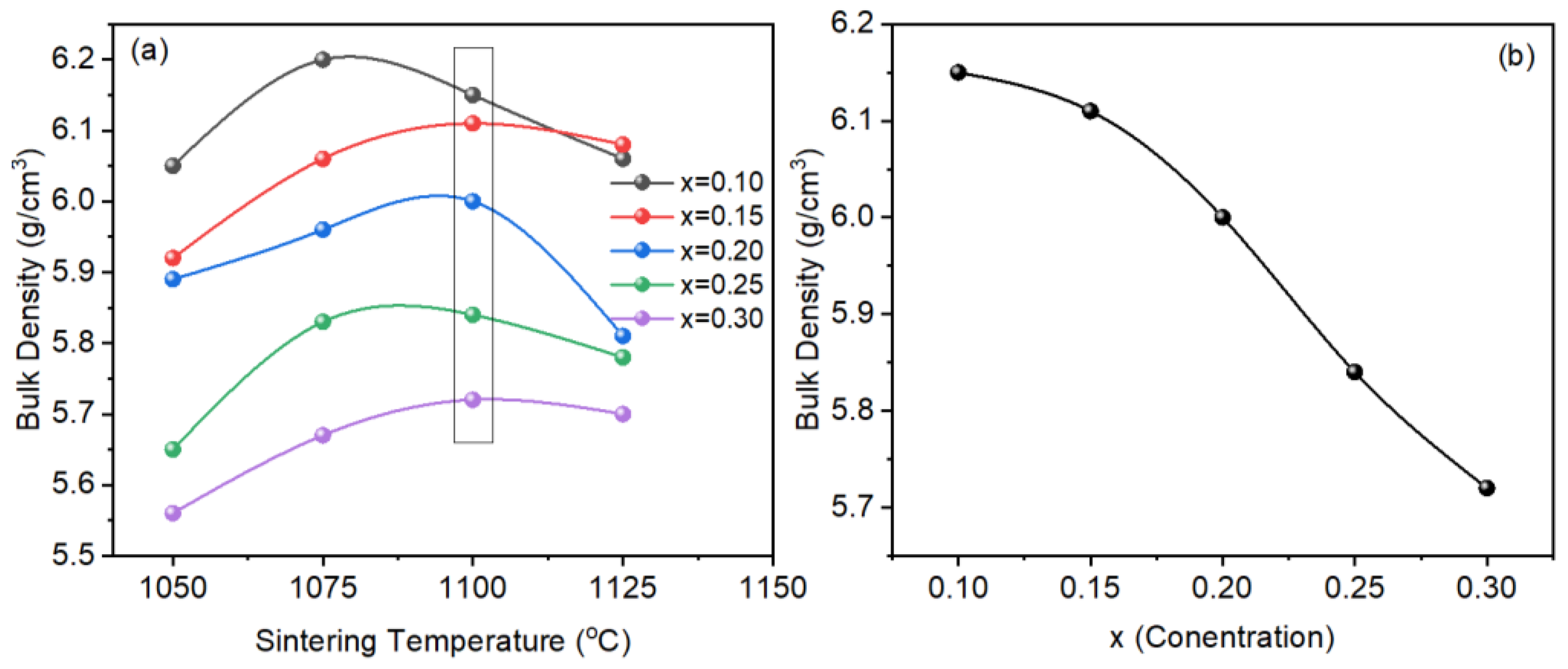


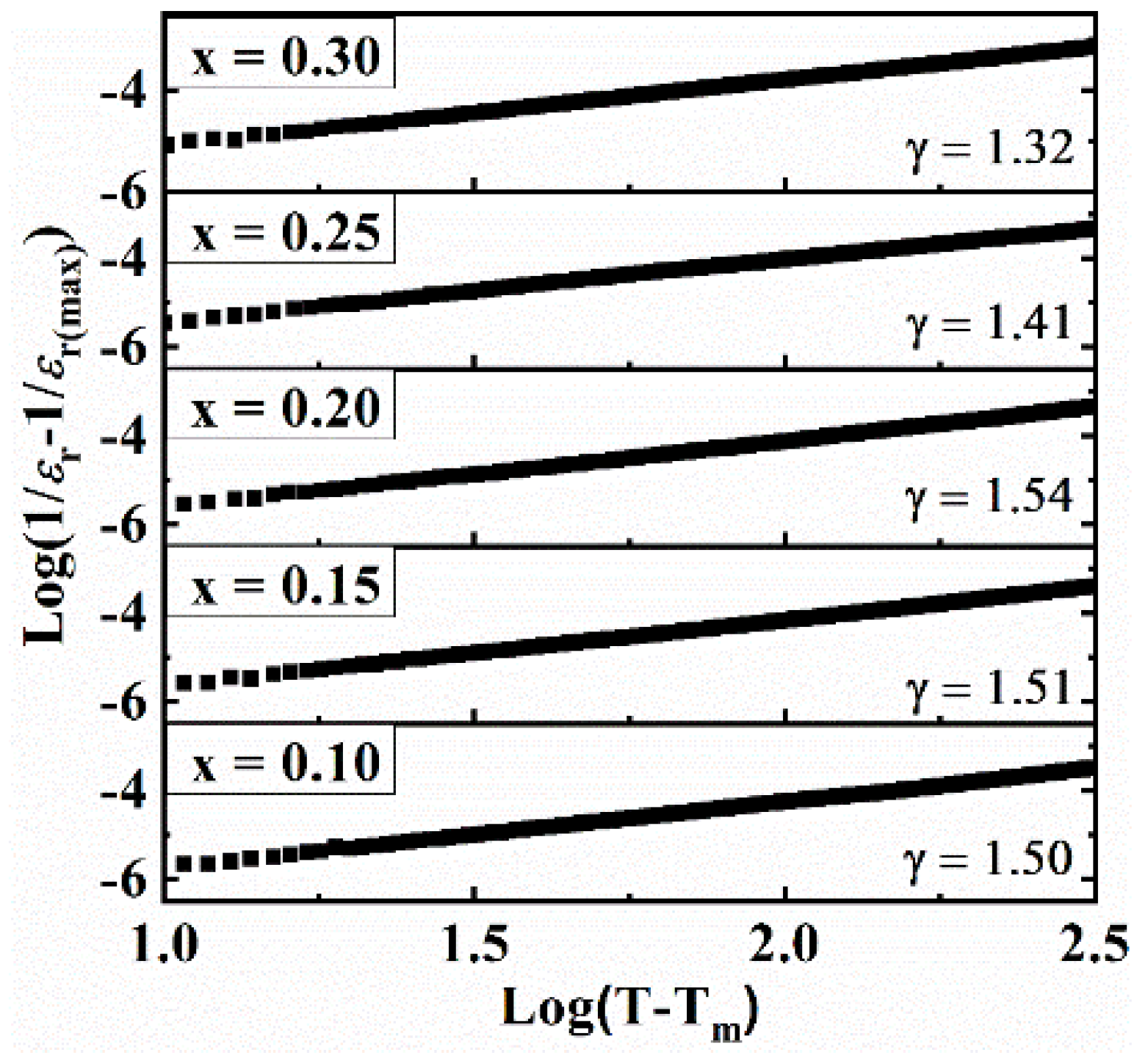
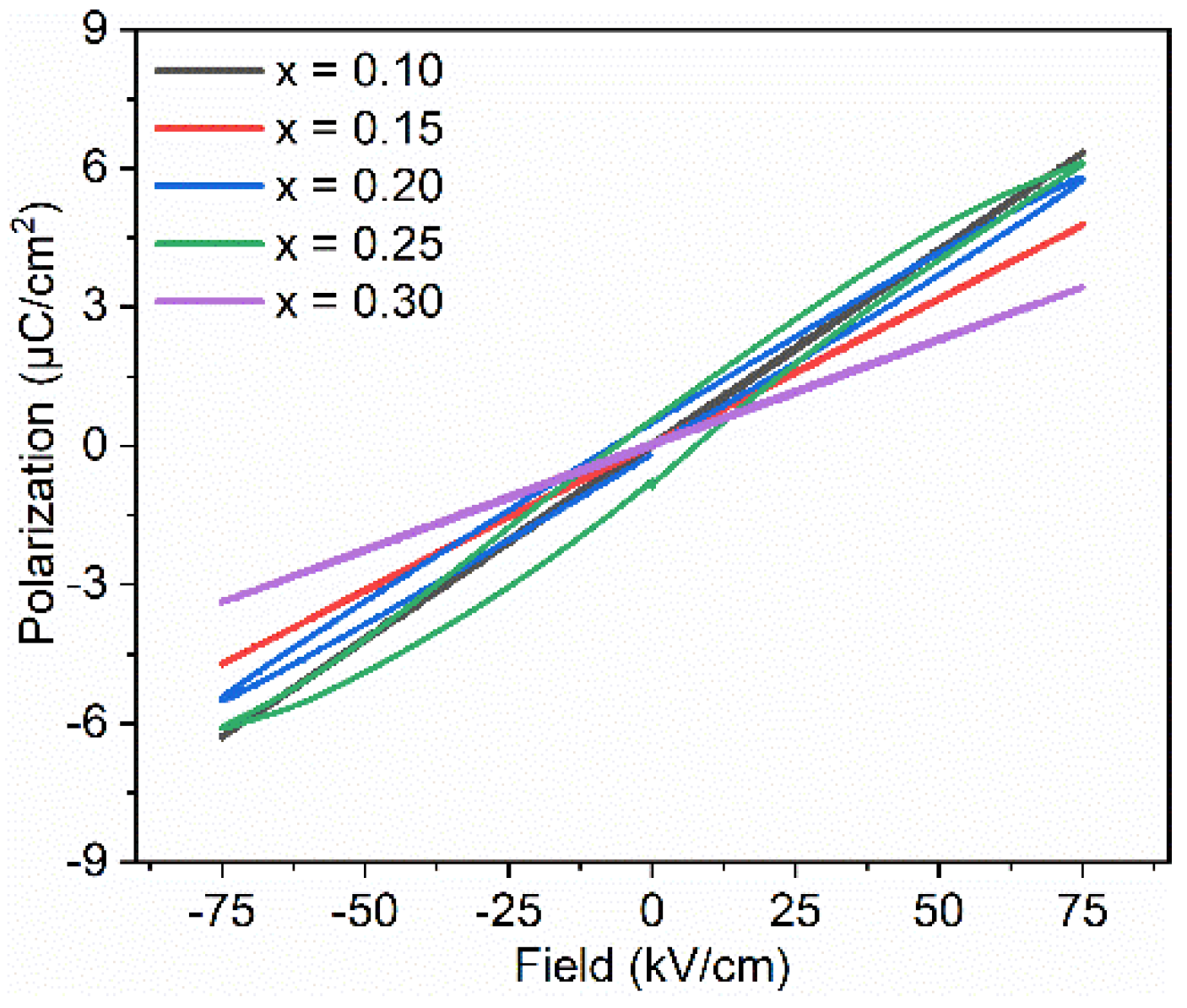
| x | Relative Density (%) | Average Grain Size (μm) |
|---|---|---|
| 0.1 | 96.0 | 1.8 |
| 0.15 | 96.8 | 1.77 |
| 0.2 | 94.4 | 1.20 |
| 0.25 | 97.8 | 1.44 |
| 0.3 | 96.5 | 1.06 |
| x | Tm (°C) | ɛr(max) | ɛr(RT) | T–Range (°C) ɛr(RT) ± 15% (1 kHz) | T–Range (°C) tan δ < 0.025 (1 kHz) | Ref. |
|---|---|---|---|---|---|---|
| 0.1 | ~91 | 890 | 850 | −8–450 | 25–412 | This work |
| 0.15 | <66 | 722 | 710 | −20–390 | −3–418 | |
| 0.2 | <28 | 656 | 655 | −43–305 | −26–400 | |
| 0.25 | 0 | 641 | 630 | −70–220 | −57–350 | |
| 0.3 | −40 | 593 | 565 | −70–165 | −62–357 | |
| Nb-doped BT-BMT | -- | -- | 764 | −55–200 | ~−25–200 | [36] |
| La-doped BT-BMT | 0 | >500 | 572 | −70–238 | −40–300 | [42] |
| BT-BiYO3 | ~50 | 417 | −55–200 | 100–200 (<0.01) | [54] | |
| BNT–SrZrO3–NN | -- | 1250 | 1170 | −55–545 | −55–300 | [55] |
Publisher’s Note: MDPI stays neutral with regard to jurisdictional claims in published maps and institutional affiliations. |
© 2022 by the authors. Licensee MDPI, Basel, Switzerland. This article is an open access article distributed under the terms and conditions of the Creative Commons Attribution (CC BY) license (https://creativecommons.org/licenses/by/4.0/).
Share and Cite
Muhammad, R.; Ali, A.; Camargo, J.; Castro, M.S.; Lei, W.; Song, K.; Wang, D. Enhanced Thermal Stability in Dielectric Properties of NaNbO3–Modified BaTiO3–BiMg1/2Ti1/2O3 Ceramics for X9R-MLCC Applications. Crystals 2022, 12, 141. https://doi.org/10.3390/cryst12020141
Muhammad R, Ali A, Camargo J, Castro MS, Lei W, Song K, Wang D. Enhanced Thermal Stability in Dielectric Properties of NaNbO3–Modified BaTiO3–BiMg1/2Ti1/2O3 Ceramics for X9R-MLCC Applications. Crystals. 2022; 12(2):141. https://doi.org/10.3390/cryst12020141
Chicago/Turabian StyleMuhammad, Raz, Asif Ali, Javier Camargo, Miriam S. Castro, Wen Lei, Kaixin Song, and Dawei Wang. 2022. "Enhanced Thermal Stability in Dielectric Properties of NaNbO3–Modified BaTiO3–BiMg1/2Ti1/2O3 Ceramics for X9R-MLCC Applications" Crystals 12, no. 2: 141. https://doi.org/10.3390/cryst12020141







